I mentioned the ErgoDox keyboard in my article A few interesting keyboards nearly in existence…. Strictly speaking, the ErgoDox was already in existence at the time (almost exactly a year ago), but as I pointed out, it wasn’t a commercial product. The ErgoDox keyboard was originally designed by Geekhack.org user Dox (aka Dominic Beauchamp), and developed in a thread started on October 10, 2011 titled ErgoDox – Custom split ergo keyboard with input from the Geekhack community. The design was based in part on the earlier Key64 concept, which itself derives its ideas from a variety of earlier keyboards, and partly from the layout of the Kinesis Advantage keyboard (in particular the thumb cluster).
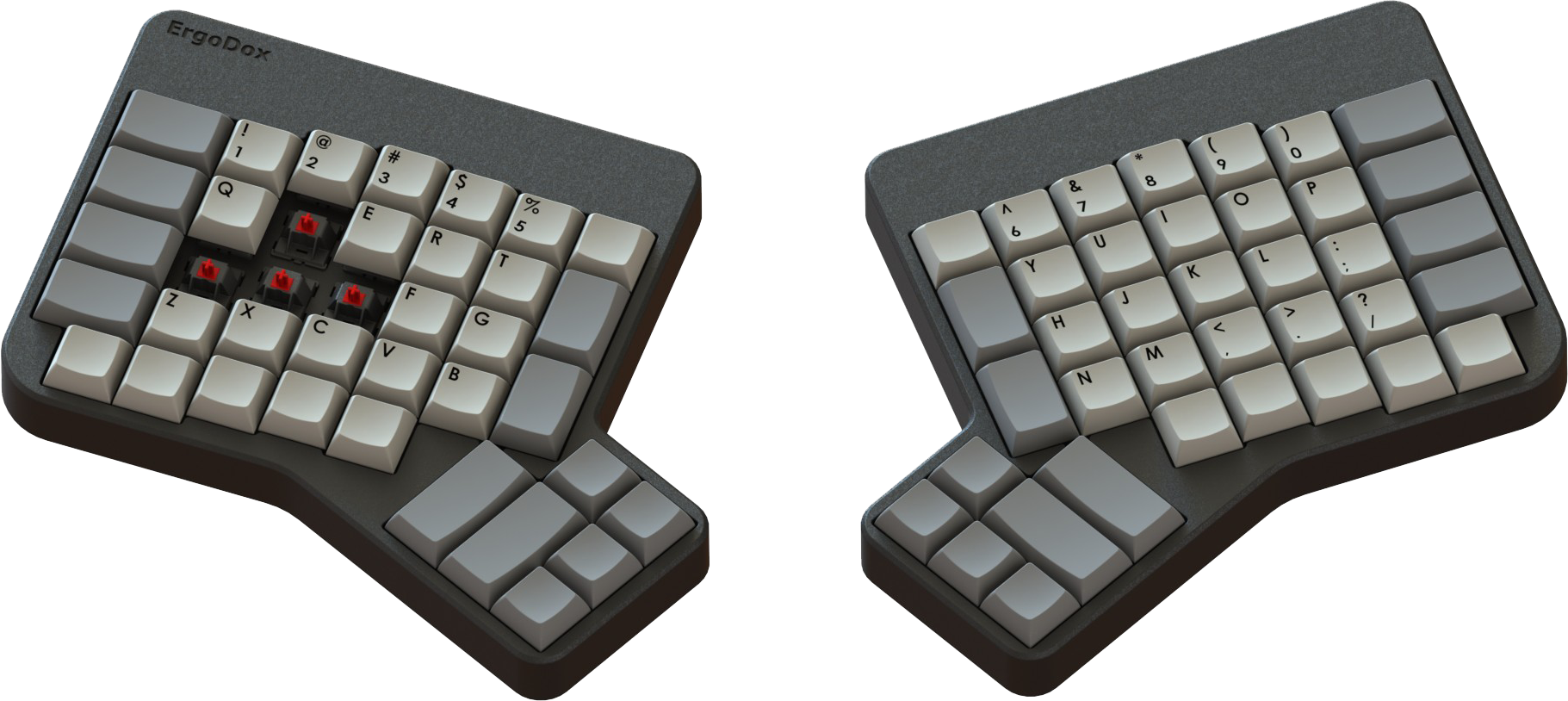
What’s amazing, considering that hundreds (maybe thousands) of ErgoDox keyboards have been sold, is that Dox was originally hoping to get 5-10 people to commit to buying it to bring down his costs. When the design was completed, and the PCB finished (the PCB design was done by geekhack user bpiphany – aka Fredrik Atmer), the design was made available for free online.
MassDrop “Group Buys”
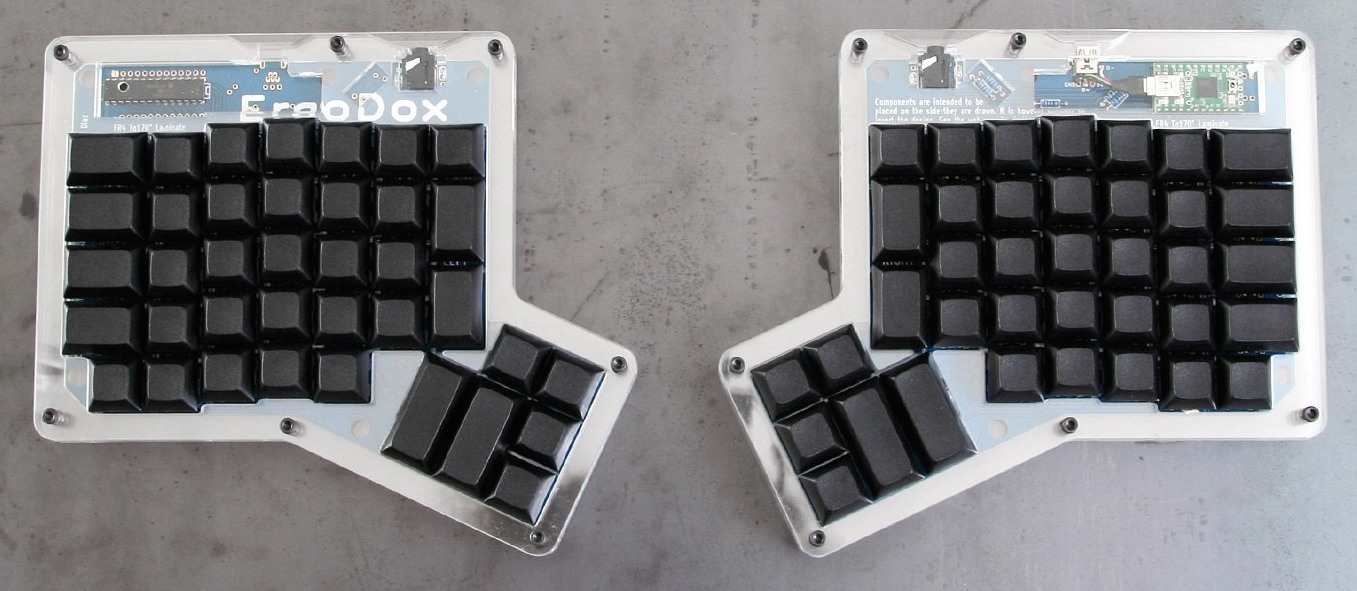
A kit containing all the parts needed to assemble the keyboard was made available first via MassDrop, a site that allows users to join “Group Buys” for various products, usually hard-to-get and/or very expensive electronics, that brings down the price based on how many people join the group buy. MassDrop has had several group buys of the ErgoDox in the past couple of years, offering the circuit boards (one for each hand), components (diodes, resistors, etc.), controller board (a Teensy 2.0), key switches, key caps, cables (USB for the computer, TRRS to connect the two sides), etc. The kit also contained a case made out of layered sheets of acrylic, based on a design by geekhack user Litster (the original 3D-printed case design by Dox was too expensive on a small scale).
Even though the kit components were sourced by MassDrop, and things like setting up custom keyboard layouts were made easier (by using an online configuration tool provided by Massdrop), it was still complicated to build, requiring the soldering of 76 key switches with 76 corresponding diodes, as well as many other components (resistors, LEDs, the controller board, the USB connection, the TRRS sockets, an I/O Expander chip, etc.). Additionally, the group buys didn’t provide a custom set of key caps for the ErgoDox, only optional blank keycaps. This could be explained by the infinite configurability of the keyboard layout not lending itself to a single set up for labels on their keycaps, but that is a cop-out of sorts. If the need to solder wasn’t enough of an obstacle, the lack of available keycaps was also an obstacle to wider adoption of the keyboard. Lastly, since you need to put the keyboard together yourself, there was no warranty on the keyboard available.
Mechanical Keyboards and Falbatech
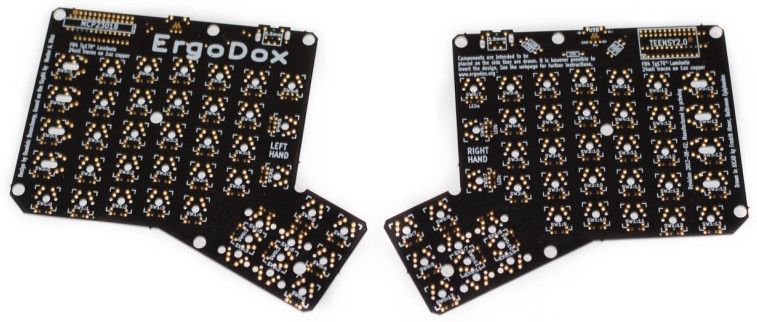
In addition to the occasional group buy via MassDrop, ErgoDox components were also available from various sources. PCBs could be bought at Mechanical Keyboards in the US and Falbatech in Poland. Both companies also offered various case options, although many people built their own cases, either from the original Dox 3D-printed case design, Litster’s cut acrylic design, or various other custom designs. Falbatech sells a component kit with all the bits and pieces one needs to solder to the PCBs as well, although most of the parts could also be sourced from other providers such as Digikey (although not as a kit). These alternate providers made it possible for people to assemble ErgoDox keyboards whenever they wanted (and no have to wait for a new group buy on MassDrop) and also allowed users more flexibility in how they assembled the keyboards.
As people built their own ErgoDox keyboards, many modified the design to suit their own needs. Some broke out the thumb cluster and repositioned them. Some designed custom cases, even from wood. Other worked to upgrade the PCB to support LEDs on each switch. Many variations of the keyboard can be found online in groups like Geekhack, Deskthority, and r/MechanicalKeyboards.
The ErgoDox EZ
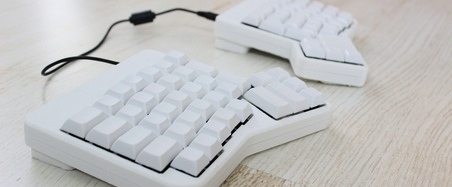
Last year I pointed out that it would be nice if the keyboard was manufactured in a factory and if the company that manufactured it offered support (i.e. a warranty). For many users, this is necessary. Apparently I wasn’t the only person who noticed this problem, as a couple of Israelis, Erez Zukerman and Yaara Lancet, put together a company to manufacture and support ErgoDox keyboards (dubbed the ErgoDox EZ). The EZ version of the ErgoDox is mass-produced in a factory in China, uses an injection-molded plastic case that brings down the cost, but otherwise is exactly the same as the standard ErgoDox. The PCBs are exactly the same, and the Teensy 2.0 is still used as the controller board. That last part was surprising to me because if I was going to mass-produce a keyboard, I’d want to embed the controller into the PCB for two reasons. I’d want to remove a third-party product from the final version to reduce costs (why include their markup into my base price?), and it would reduce the risk of problems caused by their manufacturing process. If someone is buying a mass-produced product, they probably don’t expect a removable controller board from another company. Of course, keeping the Teensy 2.0 board in the final product does have one major advantage – it means the company wouldn’t need to deal with any custom programming to adapt the ErgoDox software to a new controller configuration.
Keeping things simple (the only major change being the creation of a case that can be injection molded) might also explain why nothing in the key layout was changed either. Many people complained about the ErgoDox thumb cluster, for example, as not being ideally located. A whole thread on just this topic (fixing the ergodox thumb section) has generated hundreds of messages and thousands of views.
One other curious thing done by the EZ team was not including printed keycaps. Like MassDrop, the keycaps available are all blank. My opinion is that if they are looking to expand the market for the ErgoDox beyond those who can solder it together themselves, and those who want warranties, then chances are many of those people also want printed keycaps (see my article How many keys are there on a keyboard? for a discussion of the use of blank keycaps).
The ErgoDox EZ team did a pre-sale on its web site, offering the keyboard for $180 without keycaps or $190 with blank keycaps, in the run up to its IndieGoGo campaign, where the price was raised to $215 without and $235 with keycaps (plus $30 shipping). There was some promotion on the Deskthority keyboard forum (Assembled ErgoDox with warranty available for pre-order). Before promoting their IndieGoGo campaign, they offered the $180/$190 pricing on their IndieGoGo page for those who signed up earlier, then hid those levels once they launched officially. This got them about half way through the $50,000 they need to finish their campaign, which as of today (four days later) has 26 days to go.
The Infinity ErgoDox
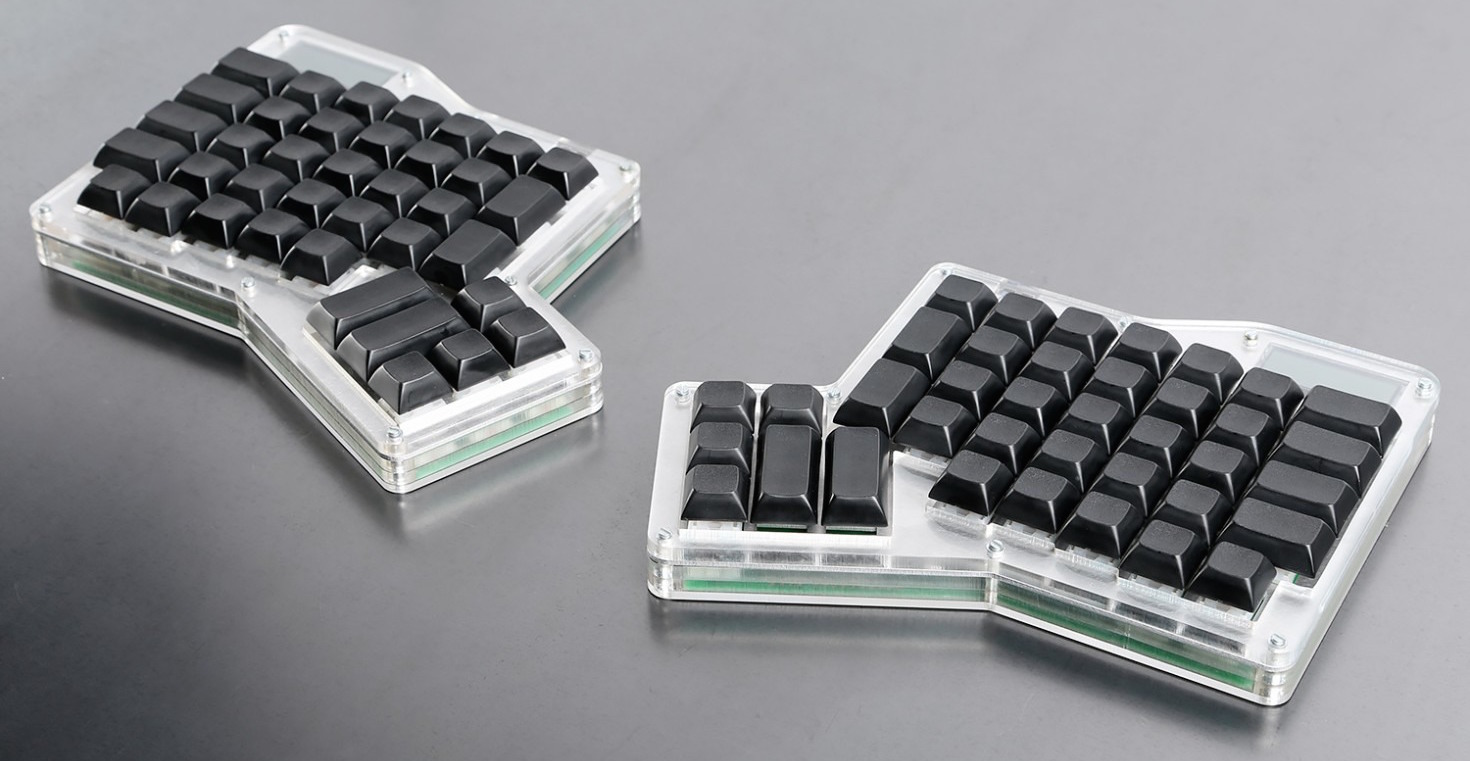
Today, just days after the ErgoDox EZ launched on IndieGoGo, MassDrop dropped a bomb of sorts – a newly redesigned ErgoDox keyboard, they’ve dubbed the Infinity ErgoDox. MassDrop previously released a keyboard called the Infinity, which was created with input from the community and the professional direction of Jacob Alexander (aka HaaTa). MassDrop has an interesting article about the creation of the Infinity for those interested in the process. MassDrop took some of the lessons learned in the creation of the Infinity, much of the feedback from the community on the original ErgoDox, and created something new.
The new model outwardly looks fairly similar to the original ErgoDox (no thumb cluster change), but when looking closer, there are some significant changes. The Teensy 2.0 is gone, replaced with a built-in controller that is closer to a Teensy 3.1 in design. Each side can actually be used independently from each other, but when combined with a USB3 cable, merges into a single device. The unit connects to the computer using a simpler USB2 cable. The new design includes one obvious change, which is the addition of a small LCD screen on both sides of the keyboard. The screen is intended to be used to show different modes of the keyboard, which layout layer is activated, etc. although the software can be modified, so the screens could be used for lots of functions.
The case is still built from layered acrylic, although the plate that holds the key switches has apparently been switched to a metal plate.
Another big change which is not actually described in the group buy description, but fleshed out in the comments, is that the keyboard supports individual per-key LEDs. The original ErgoDox only supported 3 LEDs, and all on one side of the keyboard. The new Infinity ErgoDox has room in the PCB for individual LEDs for each key, and the PCB has a built-in LED controller chip to support them. The LEDs can be individually addressed and the brighten controlled. The group buy doesn’t actually include the LEDs, which is probably why they’re not mentioned in the description, but according to the responses in the comments, the hardware support is there already. It’s possible the software support for the LEDs is not ready yet, which might also explain why that was left out of the description.
Perhaps the most important change is that all of the main components are added to the PCB during manufacturing, leaving only the switches which need to be soldered. That makes the assembly of the new Infinity ErgoDox much simpler than the original ErgoDox. If you add LEDs those will also need to be soldered, but they are not necessary to the keyboard’s operation.
What’s next?
I’m sure the ErgoDox EZ folk were not happy to see the Infinity ErgoDox launch four days into their campaign. It’s true that the ErgoDox EZ is the only version of the ErgoDox that so far will be available with a warranty. The Infinity ErgoDox does not include a warranty. Being only half-way through their fundraising goal (with 165 contributors, compared to the 280 the Infinity ErgoDox racked up today so far) they must be sweating a bit. They have a choice – they can continue and hope to get everyone who do not want to solder their keyboard switches, and those that want a warranty – or they scrap their current design and wait for MassDrop to release the new versions of their PCB design. MassDrop has announced that the designs for the Infinity ErgoDox will be released to the public after the product ships. The estimated shipping date is June 29, 2015 – three months from now. They could wait until the after it is shipped, get the new designs, and relaunch with the new design.
A third option, and probably the best option, would be for them to add stretch goals to their existing campaign that include many of the improvements in the Infinity ErgoDox, perhaps even other improvements, and commit to include those improvements in the final product (whose ship date is currently estimated to be December 2015). They could even simply add a stretch goal to use the Infinity ErgoDox design, and then they don’t need to make any new hardware designs, they only need to create a different case (which they still haven’t made, so requires very little additional work).
In any case, it’s fascinating to see what started out as a personal design intended for a handful of people, being the basis for products manufactured by many companies (besides the 4 companies mentioned here, there are many others that have made accessories such as wrist guards and custom keycaps for the ErgoDox). I don’t know if the ErgoDox EZ will make it to production and offer the first ErgoDox with a warranty, but if it does it will be a pretty big breakthrough for community-developed keyboard designs. The improvements implemented by MassDrop are also a breakthrough of sorts, taking community designs, improving them, and releasing the changes to the public. This is the open source software world merging into the world of hardware. About time.
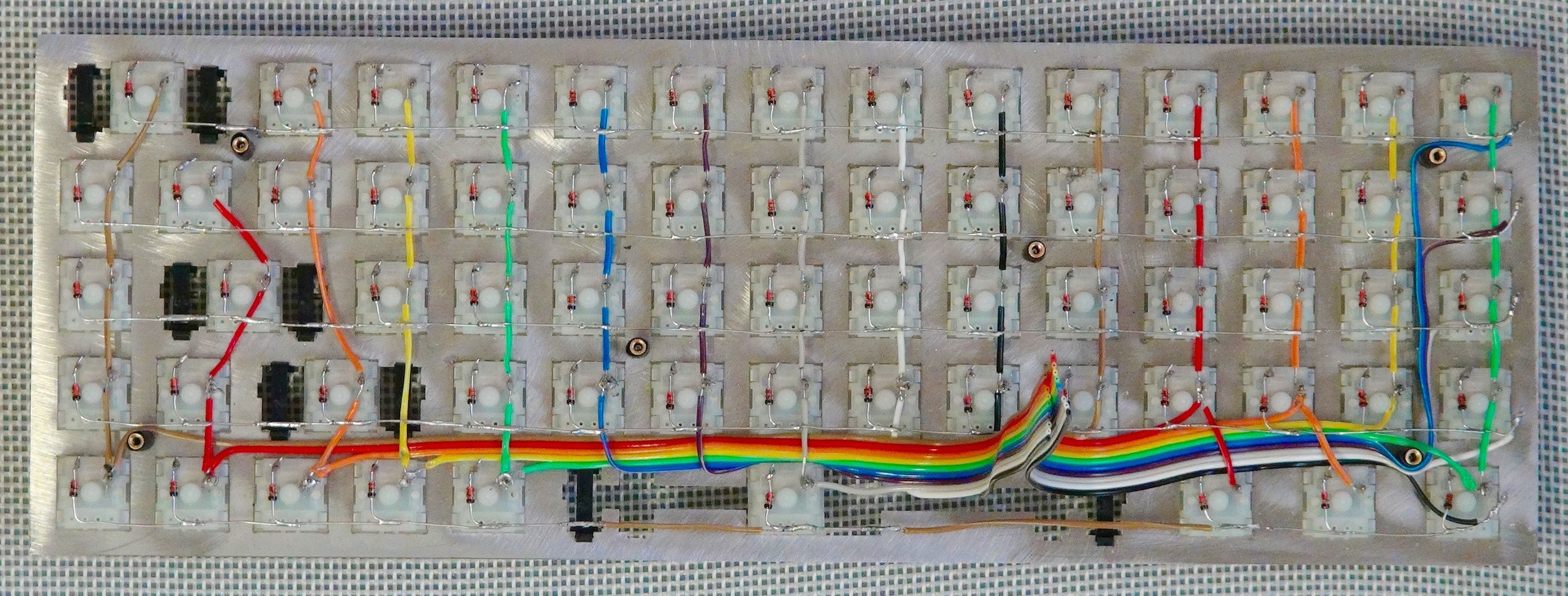
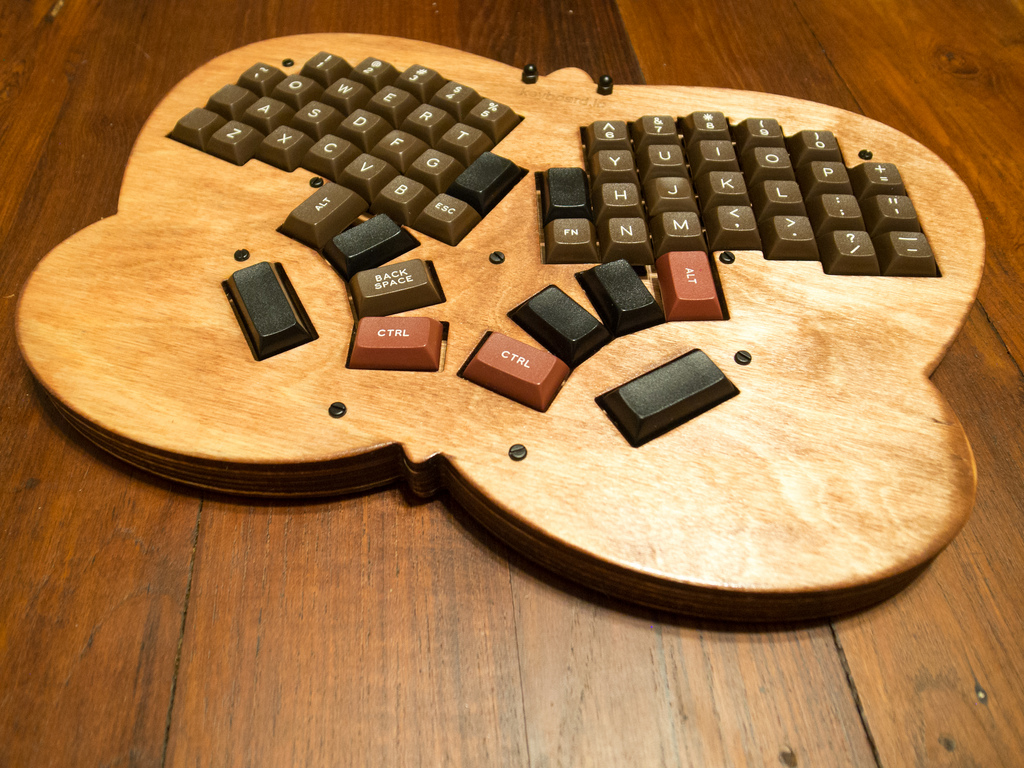
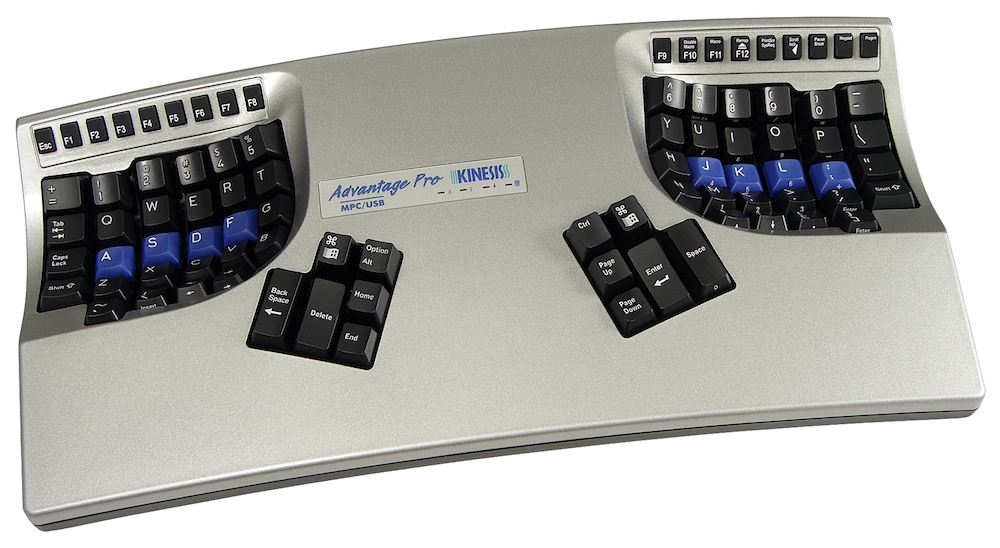
FalbaTech provides warranty as required by European legislature.
Presumably that’s only if the user paid to have the keyboard fully assembled? What are the terms of the warranty? If someone buys a PCB from Falbatech and messes up the soldering, Falbatech isn’t responsible for that…
There’s a warranty on individual parts at the very least.
It should be noted that RMA requests are (or shall be) judged only in the context of the failure, independent of unrelated usage or modifications. For example, the “removal voids warranty” stickers or Razer’s claims about keycap removal are irrelevant in Europe.
I’m not sure, how the assembly *service* is treated. IANAL.
However, the original ErgoDox design is maker-friendly by design. I don’t see, how shipping the product internationally in case of a failure helps anything (other than the growth fetish), if you can have it fixed locally by yourself, with the help of some enthusiast, or as a service.
BTW FalbaTech started as czarek’s “group buy” at Geekhack and Deskthority, because he was unhappy with Massdrop’s shipping times.
I think it’s great that Falbatech exists. It definitely fills an important role in the keyboard ecosystem. I bought ErgoDox PCBs from Falbatech myself (and the components to solder on them). I haven’t had a chance to put it together yet, but I think it’s safe to say it’s not for everyone. Indeed, the new Infinity ErgoDox simplifies the process quite a bit by only requiring you to solder in the switches (and optionally LEDs). The hardest part of the original ErgoDox definitely seems to be connecting the TRRS and USB sockets and connecting the Teensy – all not required by the new design which has the controller and connectors pre-soldered.
It will be interesting to see if Falbatech and Mechanical Keyboards start manufacturing the new Infinity ErgoDox PCBs as well (once the designs are released this summer). Perhaps they can release a version of the PCB without all the components pre-soldered, which would be unique in a way.
The ErgoDox EZ folk told me they are not interested in switching to the Infinity design, which they say is someone else’s improvements (an odd sentiment considering the whole design is someone else’s). They claim they have their own improvements in the pipeline, which is what I suggested was the best path above, but they don’t seem to be adding this to their campaign. I suspect they planned on shipping the original design first, and then offering improvements later. The Infinity ErgoDox definitely threw a wrench into the works for them. I could be wrong, but it seems like they added back the early-bird pricing of $190 (with keycaps) to their campaign, and even featured it. I thought they removed that, so it’s possible they added it back to try to spur more people to contribute. They only show 110 out of 240 early-bird options, which means if they get just over a hundred people to buy at that price ($190+$30 shipping) they can get past $50,000. I wonder if they notified the 9 people who are listed as buying it at the full $235 price that the early-bird pricing is now available again. Of course, it’s a Flexible Funding campaign, so they’ll get whatever money there is even if they don’t hit their $50K goal, but I wonder if they can complete the project without the full amount of money.
Hey Philip,
Let’s see if I can answer some of these. 🙂
1) The improvements we’ll be offering are coming in about ~2 weeks. We were going to offer them in the campaign anyway — and it’s not something Massdrop (or any other version of the ErgoDox) is currently offering.
2) We did bring the $190 option back. 🙂 Happy to offer the keyboard at this price point for now, until it runs out.
3) If we miss the goal by a long shot, we may have a problem. But it looks like we’re going to make it, and probably surpass it.
4) Re the Infinity innovations: Well, for one thing, they didn’t release them yet. For another thing, it’s quite different from just using the ErgoDox design — they are effectively our competitors. We enjoy competing against them and we feel we have a superior product here — and directly using any of their ideas at this point just isn’t where we want to put ourselves.
In a future version, once they release it, and after we make sure there are no IP issues — sure. But for now, we offer plenty that they don’t (a better price, an assembled keyboard, a better shell, warranty).
Pingback: Getting Started With The ErgoDox EZ, A Different Type Of Split Keyboard - IT AND US